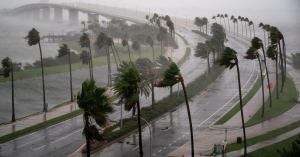Two Tropical Storms, Marco and Laura, are headed for the U.S., and forecasters say that both are likely to become hurricanes by the time they get here. As of Sunday morning, the two storms are both heading into the Gulf of Mexico, and are still picking of strength. If they make it, it would be the first time two hurricanes had appeared in the Gulf of Mexico at the same time in written history, according to a report by The Guardian.
Tropical Storm Marco is on a collision course with the coast of Louisiana, while Tropical Storm Laura is not far behind. Laura reportedly devastated Hispaniola as it passed, knocking out utilities and battering the community with heavy rains and harsh winds. Laura is currently projected to hit the U.S. in nearly the same spot as Marco, but the latest forecast from the National Hurricane Center says that the two storms are not expected to interact.
Videos by PopCulture.com
Portions of the U.S. Gulf coast are likely to experience a prolonged period of hazardous weather this week due to #Marco and #Laura. Follow @NWSKeyWest, @NWSMobile, @NWSNewOrleans, @NWSLakeCharles, and @NWSHouston for the latest local forecast information in the affected areas. pic.twitter.com/glWZvxhTPU
— National Hurricane Center (@NHC_Atlantic) August 23, 2020
On Sunday morning, an official hurricane watch was issued for the New Orleans metro area, and a state of emergency was declared in Mississippi. Current forecasts show the Marco impacting the coast around midday on Monday, and Laura on Wednesday. However, these early projections are subject to change.
“We are in unprecedented times,” said Mississippi Governor Tate Reeves. “We are dealing with not only two potential storms in the next few hours, we are also dealing with Covid-19.”
The storms have brought flooding and destruction to parts of the Caribbean, including Haiti and the Dominican Republic, with Cuba expected to get hit late on Sunday. Like the east coast of the U.S., many of these communities are still recovering from Hurricane Isaias earlier this month.
The approach of Tropical Storms Marco and Laura have revived concerns about this “unusually active” hurricane season among meteorologists. It is especially ominous as President Donald Trump’s recent executive order begins drawing on funds from FEMA to fund unemployment payment. The program is authorized to take up to $44 billion from a fund usually reserved for disaster relief, leaving just $25 billion to deal with storms like these for the rest of the year.
Among scientists, there is little doubt that the intensifying strength and frequency of hurricanes, as well as their changing movement patterns over the last few years, are related to climate change. The 2018 U.S. National Climate Change Assessment reported that “increases in greenhouse gases and decreases in air pollution have contributed to increases in Atlantic hurricane activity since 1970.”
Related Posts
-

Fort Myers Beach ahead of Hurricane Ian in Fort Myers, Florida, US, on Wednesday, Sept. 28, 2022. Hurricane Ian rapidly gained strength — with winds reaching 155 miles an hour — as it barreled toward the coast of Florida, threatening to rip roofs off of homes, wreck agricultural crops and cripple infrastructure as one of the costliest storms to ever hit the US. Photographer: Eva Marie Uzcategui/Bloomberg




